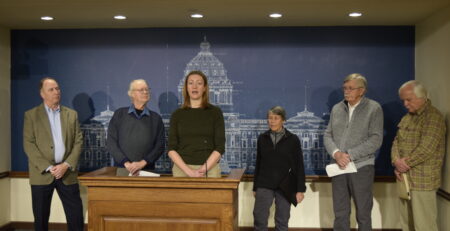February 2024 Macro of the Month

Winter-Emerging Midges
Photo credit: Chironomidae Research Group
In the frigid heart of winter, a hidden world of resilience unfolds beneath the icy surfaces of Minnesota’s streams. Enter the winter-emerging chironomids (aka “midges”), tiny aquatic flies belonging to the Chironomidae family. Resembling miniature black mosquitoes, some types of these resilient insects defy the cold, walking on snow, armed with an internal antifreeze protein. Among the at least 11 Minnesota species that brave the winter chill, the spotlight often falls on Diamesa, a cold-adapted genus with a remarkable life cycle.
In the spring-fed streams of southeastern Minnesota, Diamesa larvae thrive on periphyton, a biofilm of algae and microbes, requiring cool waters with ample dissolved oxygen. Their journey from larvae to adults is a testament to survival strategies. Diamesa, particularly the widespread D. mendotae, exhibit freeze tolerance, allowing them to remain active in subzero temperatures. This ability not only aids in mating and ovipositing at low temperatures but also extends their adult lifespan, contributing to successive generations – perhaps 2 or 3 in a single winter season!
Although much of their life is spent underwater as larvae, emergent adults may live around 18 days as adults, during which males and females mate in swarms on warm days when temperatures are below 0°C. After mating, female Diamesa return to the stream to lay masses of hundreds of eggs on substrates near the edge of the water.
However, the significance of freeze tolerance in Diamesa larvae remains a mystery. While most are found in thermally buffered groundwater habitats, some brave streams that freeze in winter, leaving questions about their migration and potential exposure to freezing risks.
How important are midges for trout? Recent studies in southeastern Minnesota have shown that winter-emerging midges are an important food source for trout during winter, in part due to the fact that midge populations are thriving – actively growing, emerging, and reproducing – during the coldest months when most other aquatic insects are in diapause. (Diapause means not growing, emerging, or reproducing – essentially populations become naturally depressed.) In fact, it’s not uncommon to find a trout stomach packed with dozens – or even hundreds – of midges during this time of year.
To learn more about midges, check out the Bugs Below Zero project at the University of Minnesota – which also offers a citizen science and angler-friendly opportunity to help track these and other aquatic invertebrates that emerge in the colder months. To learn more about the science of winter-emerging midges, head to the Chironomid Research Group at the University of Minnesota.
Check out this awesome video from MNTU member Paul Johnson on how to tie your own Zebra Midge Fly!
Sources:
Winter-Active Chironomidae | Chironomidae Research Group (umn.edu)
Jennifer Lynn Cochran-Biederman & Bruce Vondracek (2017) Seasonal feeding selectivity of brown trout Salmo trutta in five groundwater-dominated streams, Journal of Freshwater Ecology, 32:1, 653-673, DOI: 10.1080/02705060.2017.1386595
What’s a macro and what’s it have to do with trout angling and conservation? Macros are on the trout menu for pretty much every meal. Macro means big and macroinvertebrates, or “macros,” are animals without a backbone, that are big enough to be seen by the human eye. They can be aquatic or land based, however aquatic insects make up the majority of a trout’s diet. They are also, of course, the inspiration for the flies we tie and use to catch trout. Learn about a new macro each month and how you can create your own to take with you on your next fishing trip!


